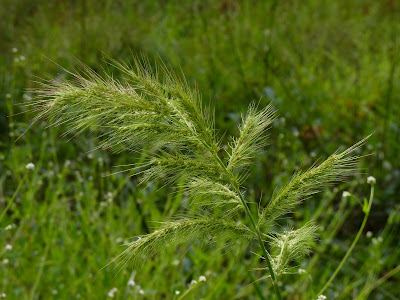Recently someone asked me questions about particular grasses, and I realized I could not answer them because I knew next to nothing about grasses. I mean, I can recognize certain grasses like the ubiquitous Phragmites australis and a few other wetland grasses like cattails and Spartina. Beyond those, though, my knowledge is very limited. So I have been making an effort to learn more about the grasses I encounter in the types of habitats I bird frequently.
Grasses (family Poaceae) are an incredibly important group. Wheat, oats, barley, rye, corn, and rice are all grasses, as is bamboo. Many species of butterflies and moths, such as skippers and grass-veneers, use grasses as their larval host plants. Some bird species also associate with particular grasses or depend on habitats where grasses predominate. Along with grasses, rushes (family Juncaceae) and sedges (family Cyperaceae) may be found in those sorts of habitats and present similar identification challenges. Grasses, sedges, and rushes are all in the order Poales, along with many other plant families.
Another wetland grass is cockspur (Echinochloa sp.). Plants in this genus are sometimes grown as forage crops for livestock, but otherwise just grow wild. I think this is E. walteri, a grass of both saltwater and freshwater marshes that characteristically long bristles along its spikelets.
Like grasses, rushes have round stems, but their flowers and seeds are structured somewhat differently. On this Soft Rush (Juncus effusus), the flowers burst in a clump from the side of the stem rather than emerging from the top.
Sedges are another group of plants that grow in wetlands and meadows. As a group, sedges are fairly easy to recognize because most of them have obviously triangular stems ("sedges have edges"). Narrowing down to a species, though, can be more difficult. I think the plant above is a Dark Green Bulrush (Scirpus atrovirens), which shows one common sedge structure. The main stem ends in a leafy bract, from which several branches emerge that bear the sedge's flowers. Another plant that shares a similar structure is Yellow Nutsedge.
So far I have been aided in my learning by Grasses: An Identification Guide by Lauren Brown. This guide, published by Houghton Mifflin, uses simplified terminology and emphasizes broad characteristics such as shape and color rather than minute details. (The latter, unfortunately, may still be necessary to confirm a species identification.) The book contains a key followed by descriptions of 135 species from the Midwest and Northeast. I have found it very helpful as an entry point to learning about grasses.







